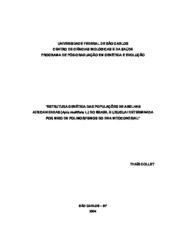| dc.contributor.author | Collet, Thaís | |
| dc.date.accessioned | 2016-06-02T20:21:27Z | |
| dc.date.available | 2005-01-10 | |
| dc.date.available | 2016-06-02T20:21:27Z | |
| dc.date.issued | 2004-08-25 | |
| dc.identifier.citation | COLLET, Thaís. Estrutura genética das populações de abelhas africanizadas (Apis mellifera L.) do Brasil determinada por meio de polimorfismos do DNA mitocondrial.. 2004. 80 f. Dissertação (Mestrado em Ciências Biológicas) - Universidade Federal de São Carlos, São Carlos, 2004. | por |
| dc.identifier.uri | https://repositorio.ufscar.br/handle/ufscar/5494 | |
| dc.description.abstract | The Apis mellifera subspecies are classified into evolutionary branches originally distributed in the African (branches A and Y), European (branches C and M) and Asian (branch O) continents. This distribution has been changing due to the subspecies introductions to other countries, mainly occurred by beekeeping activities. Therefore, population genetics studies on the already established and newly introduced populations have increased. The introduction of the African honeybee in American continent, known as Africanization, became one of the most studied events related to Apis mellifera introductions. The characterization of different lineages that contribute to hybrid populations is the first approach of the studies related to subspecies introductions. In this way, we describe the restriction patterns obtained from a 16S region fragment of the mitochondrial DNA. These patterns enables the differentiation among races from the three evolutionary branches using only one region of the mitochondrial genome, without the requirement of amplification of other regions.
The determination of the racial composition of the hybrid product of Africanization in America led to the development of diverse tools suitable for it, including mtDNA analysis. We present here the results obtained with the polymorphism produced by Dra I endonuclease in a fragment of the tRNAleu_COII intergenic region. These results contribute to the understanding of the genetic structure of Africanized populations from Brazil. From 11 mitotypes observed, three have not been described in previous analysis and present similar patterns to some found at Iberian Peninsula. The most frequent patterns were the African A1 and A4, probably introduced in Brazil by Apis mellifera scutellata in 1956. Although the patterns analyzed in this work are more informative than the ones used until now in
Africanized populations, the distribution of A1 pattern evidences the importance of using other mitochondrial regions to identify its origin. Working with these regions and other markers, it will be possible to clarify the genetic structure of Africanized honeybees of the Americas. | eng |
| dc.description.sponsorship | Universidade Federal de Sao Carlos | |
| dc.format | application/pdf | por |
| dc.language | por | por |
| dc.publisher | Universidade Federal de São Carlos | por |
| dc.rights | Acesso Aberto | por |
| dc.subject | Genética de populações | por |
| dc.subject | Abelha - africanizadas | por |
| dc.subject | Apis mellifera | por |
| dc.subject | DNA mitocondrial | por |
| dc.title | Estrutura genética das populações de abelhas africanizadas (Apis mellifera L.) do Brasil determinada por meio de polimorfismos do DNA mitocondrial. | por |
| dc.type | Dissertação | por |
| dc.contributor.advisor1 | Del Lama, Marco Antonio | |
| dc.contributor.advisor1Lattes | http://lattes.cnpq.br/7198095288825585 | por |
| dc.description.resumo | Os ramos evolutivos dentro dos quais as subespécies de Apis mellifera são classificadas estão originalmente distribuídos nos continentes africano (ramos A e Y), europeu (ramos M e C) e asiático (ramo O). Essa distribuição vem sendo
progressivamente alterada devido às introduções de subespécies em várias outras regiões do mundo, ocasionadas principalmente por atividades apícolas. Dessa forma, a genética de populações vem ganhando um amplo campo de estudos relacionados às mudanças na composição das populações já estabelecidas e das recém introduzidas. A introdução das abelhas africanas no continente americano, que resultou no processo conhecido como africanização, se tornou um dos eventos mais estudados, dentre aqueles relacionados às introduções de Apis mellifera. Uma das primeiras abordagens nos estudos que envolvem introduções de subespécies é a caracterização das diferentes linhagens que contribuem para a formação das populações. Nesse sentido, são descritos neste trabalho os diferentes padrões de restrição obtidos a partir de um fragmento da região 16S do DNA mitocondrial que, em relação às metodologias utilizadas até então, permitem uma melhor diferenciação das subespécies pertencentes aos ramos evolutivos A, M e C. No sentido de caracterizar a composição racial da abelha híbrida resultante da africanização do continente americano, a necessidade de identificar a contribuição de raças européias e africanas para as populações africanizadas que
se expandiram a partir da década de 50 levou ao desenvolvimento de diversas ferramentas adequadas para tal fim. Portanto, são apresentados os resultados obtidos com o polimorfismo gerado pela enzima Dra I em fragmento da região intergênica tRNAleu_COII que contribuirão para o entendimento da estrutura genética das populações de abelhas africanizadas do Brasil. Dos 11 mitótipos observados, três não haviam sido descritos em análises prévias e apresentam padrões similares a alguns encontrados na Península Ibérica. Os padrões mais freqüentes foram os africanos A1 e A4, provavelmente introduzidos no Brasil via Apis mellifera scutellata em 1956. Embora os padrões analisados neste trabalho tenham se mostrado mais informativos em relação aos anteriormente utilizados nas populações africanizadas, a distribuição do padrão A1 evidencia a importância de se utilizar regiões mitocondriais ainda mais polimórficas, cujos resultados, aliados a outros marcadores, trarão maiores esclarecimentos a respeito da estrutura genética das populações de abelhas africanizadas das Américas. | por |
| dc.publisher.country | BR | por |
| dc.publisher.initials | UFSCar | por |
| dc.publisher.program | Programa de Pós-Graduação em Genética Evolutiva e Biologia Molecular - PPGGEv | por |
| dc.subject.cnpq | CIENCIAS BIOLOGICAS::GENETICA | por |
| dc.contributor.authorlattes | http://lattes.cnpq.br/3345994967493962 | por |
